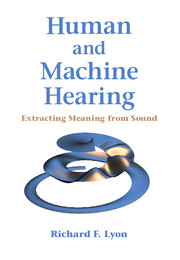Book contents
- Frontmatter
- Dedication
- Contents
- Foreword
- Preface
- Part I Sound Analysis and Representation Overview
- Part II Systems Theory for Hearing
- 6 Introduction to Linear Systems
- 7 Discrete-Time and Digital Systems
- 8 Resonators
- 9 Gammatone and Related Filters
- 10 Nonlinear Systems
- 11 Automatic Gain Control
- 12 Waves in Distributed Systems
- Part III The Auditory Periphery
- Part IV The Auditory Nervous System
- Part V Learning and Applications
- Bibliography
- Author Index
- Subject Index
- Plate section
7 - Discrete-Time and Digital Systems
from Part II - Systems Theory for Hearing
Published online by Cambridge University Press: 28 April 2017
- Frontmatter
- Dedication
- Contents
- Foreword
- Preface
- Part I Sound Analysis and Representation Overview
- Part II Systems Theory for Hearing
- 6 Introduction to Linear Systems
- 7 Discrete-Time and Digital Systems
- 8 Resonators
- 9 Gammatone and Related Filters
- 10 Nonlinear Systems
- 11 Automatic Gain Control
- 12 Waves in Distributed Systems
- Part III The Auditory Periphery
- Part IV The Auditory Nervous System
- Part V Learning and Applications
- Bibliography
- Author Index
- Subject Index
- Plate section
Summary
Since a sufficiently approximate solution of many differential equations can be had simply by solving an associated difference equation, it is to be expected that one of the chief fields of usefulness for an electronic computor would be found in the solution of differential equations.
—“The use of high-speed vacuum tube devices for calculating,” John Mauchly (1942)Simulating Systems in Computers
When we build or model linear (or nonlinear) systems in computers, we use discrete time steps. The relationship between discrete-time and continuous-time linear systems, and the implementation of such systems in digital computer software, are introduced in this chapter. Fortunately, all of the representations and techniques used for discrete-time linear systems are exact counterparts of those used for continuous-time linear systems, with difference equations taking the place of differential equations, and Z transforms taking the place of Laplace transforms, as we explain below.
A discrete-time system operates with quantized time, and can be linear. A digital system, or digital filter, on the other hand, represents signals as quantized in both time and amplitude, and therefore cannot be precisely linear. Digital systems are what we can make with digital hardware or software. In the old days of digital filters (1960s and 1970s), people worried a lot about quantization effects, the manifestations of the digital number system's nonlinearity. In more modern times, however, this distinction between discrete-time and digital is typically ignored, as we economically operate with digital floating-point number systems with enough resolution to simulate linear discrete-time systems with more than enough accuracy. Still, when we say digital filter we're likely referring to a computer implementation that can process a signal, as opposed to a discrete-time linear system which refers to a more idealized analytical model.
Discrete-Time Linear Shift-Invariant Systems
Electrical, mechanical, and other physical systems, such as those in our ears, are continuous-time systems, whether linear or not. But when we build computer-based systems to process sounds, we work on samples of sound waveforms, measured at (usually) equally-spaced sample times. So we use the theory of discrete-time linear systems, which are in most respects analogous to continuous-time linear systems.
- Type
- Chapter
- Information
- Human and Machine HearingExtracting Meaning from Sound, pp. 126 - 144Publisher: Cambridge University PressPrint publication year: 2017



